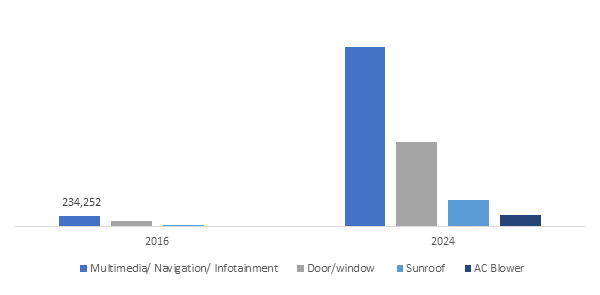Global automotive gesture recognition market valuation to cross USD 13 billion by 2024, rising popularity of the 3D gesture recognition concept to drive the industry trends
Publisher : Fractovia | Published Date : 2018-03-08Request Sample
With the intervention of AI bringing forth a new wave of opportunities for mobility, automotive gesture recognition market stands to gain commendable upsurge over the ensuing years. The influence of disruptive technology driven trends is seen to be quite impactful in the auto industry. This originates from the scenario where the business space has been transiting from hardware to software-based model. Automotive gesture recognition market seems to be a major beneficiary of this change.
U.S. Automotive Gesture Recognition Market, By Application, 2016 & 2024, (Units)

Automotive HMI (Human-Machine Interface) technology is proliferating at such a rapid pace that today it can enable real-time communication between driver and the vehicle system without distraction, even while driving the vehicle. Add to it, recent developments in gesture recognition systems have also brought a change in conventional dashboard layout from static to a more dynamic adaptable design. On grounds of this widespread acclaim, numerous automotive gesture recognition market giants have been trying their hands out on improvising the technology.
In this regard, 3D gesture recognition concept is taking the industry space by storm. Supported by multiple image sensors, this highly specific user interface systems allegedly are capable of generating data from any distance, which represent three dimensional spaces all across the device. A few years back, in 2015, Visteon, one of the formidable players in automotive gesture recognition industry, grabbed the headlines with its first showcase of a 3D gesture recognition enabled multipurpose vehicle at Beijing motor show. Equipped with time-of-flight camera technology and image processing algorithm, the groundbreaking system effectively recognizes certain predefined hand movements to perform different operations. Reportedly, the system could also distinguish between passenger and driver hand gestures, in addition to allowing customizable hand gestures.
Citing another instance in automotive gesture recognition marketplace- Ultrahaptics has recently launched STRATOS haptic sensation creator. As per reliable sources, the new technology platform can generate advanced haptic sensations in mid-air, including immersive effects, 3D shapes, and high-quality HMI control applications. Allegedly, this groundbreaking technology can be used across a plethora of applications spanning from control to immersive environments. Experts have been already raving about the innovation, aiming to utilize its full potential in as many applications as possible. As reported by the company officials, integrating this mid-air haptic feedback control with gesture recognition technology can result in more intuitive and safer control in automotive infotainment. Pertaining to these unique features, the STRATOS platform is undeniably on its way to set a new standard in automotive gesture recognition industry.
While elaborating on the latest trends pervading in automotive gesture recognition market, the hefty investments by the renowned automakers like BMW, Volkswagen, Audi in this technology is worth quoting. In this regard Volkswagen’s premium class concept car I.D. VIZZION, sent out waves of anticipation in automotive gesture recognition market. An absolute state-of-the art version of its predecessor, I.D. family, this next generation avant-garde saloon is claimed to be fully operated by gesture and voice control. Since the vehicle is fully integrated by gesture recognition systems, there would be no driver seat, dash panel, and steering wheels, cite sources. Allegedly, this highlight of the I.D. family would be showcased by the German automaker at the Geneva International Motor Show. This breakthrough model undoubtedly represents one of the most apt instances where gesture recognition technology has been maximally exploited.
Considering the aforementioned axioms, it can be concluded that automotive gesture recognition industry is set to explore a plethora of opportunities on a global scale. However, high cost and complexity associated with its integration are two of the major challenges that market players are presently dealing with. In a bid to upgrade existing systems, manufacturers are compelled to integrate advanced sensor technology which is further resulting in increased capital investment.
Nonetheless, with increasing implementation of driver safety regulations by regional governments, the deployment of automotive gesture recognition system would certainly be on rapid incline in developing nations. Global Market Insights, Inc forecasts overall automotive gesture recognition market size to exceed a valuation of USD 13 billion by 2024.